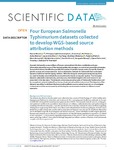Four European Salmonella Typhimurium datasets collected to develop WGS-based source attribution methods
Munck, Nanna
Leekitcharoenphon, Pimlapas
Litrup, Eva
Kaas, Rolf
Meinen, Anika
Guillier, Laurent
Tang, Yue
Malorny, Burkhard
Palma, Federica
Borowiak, Maria
Gourmelon, Michèle
Simon, Sandra
Banerji, Sangeeta
Petrovska, Liljana
Dallman, Timothy J.
Hald, Tine
Zoonotic Salmonella causes millions of human salmonellosis infections worldwide each year. Information about the source of the bacteria guides risk managers on control and preventive strategies. Source attribution is the effort to quantify the number of sporadic human cases of a specific illness to specific sources and animal reservoirs. Source attribution methods for Salmonella have so far been based on traditional wet-lab typing methods. With the change to whole genome sequencing there is a need to develop new methods for source attribution based on sequencing data. Four European datasets collected in Denmark (DK), Germany (DE), the United Kingdom (UK) and France (FR) are presented in this descriptor. The datasets contain sequenced samples of Salmonella Typhimurium and its monophasic variants isolated from human, food, animal and the environment. The objective of the datasets was either to attribute the human salmonellosis cases to animal reservoirs or to investigate contamination of the environment by attributing the environmental isolates to different animal reservoirs.
Dateien zu dieser Publikation

